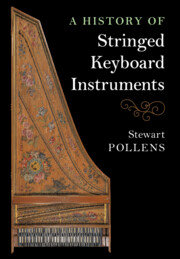Book contents
- A History of Stringed Keyboard Instruments
- A History of Stringed Keyboard Instruments
- Copyright page
- Contents
- Figures
- Tables
- Preface and Acknowledgments
- Pitch Notation Conventions
- One Keyboard Origins
- Two Principles of Design and Construction
- Three The Henri Arnaut Manuscript
- Four The Renaissance
- Five The Baroque Period
- Six The Invention of the Piano
- Seven The Classical Period
- Eight The Romantic Era
- Nine Stagnation and Revival
- Bibliography
- Index
Three - The Henri Arnaut Manuscript
Published online by Cambridge University Press: 03 April 2022
- A History of Stringed Keyboard Instruments
- A History of Stringed Keyboard Instruments
- Copyright page
- Contents
- Figures
- Tables
- Preface and Acknowledgments
- Pitch Notation Conventions
- One Keyboard Origins
- Two Principles of Design and Construction
- Three The Henri Arnaut Manuscript
- Four The Renaissance
- Five The Baroque Period
- Six The Invention of the Piano
- Seven The Classical Period
- Eight The Romantic Era
- Nine Stagnation and Revival
- Bibliography
- Index
Summary
This chapter includes a transcription, translation, and analysis of Henri Arnaut (also spelled Arnault) of Zwolle’s manuscript in the Bibliothèque National in Paris (Ms. Latin 7295). This manuscript dates from around 1440 and was written while Henri Arnaut was in service to Philip the Good in Burgundy. It provides detailed and illustrated instructions for the design of several types of keyboard instruments termed the clavisimbalum, dulce melos, and clavicorde. Four different mechanisms are described and pictured, including three that pluck the strings and one that strikes the strings. The striking mechanism, which Arnaut informs us could be installed in various forms of keyboard instruments regardless of their names (thus the clavisimbalum or dulce melos) indicates that the “piano” was not a later development but was contemporary with the harpsichord and clavichord. For some reason, it fell by the wayside only to appear sporadically until its final “invention” by Bartolomeo Cristofori around 1700.
Keywords
- Type
- Chapter
- Information
- A History of Stringed Keyboard Instruments , pp. 142 - 165Publisher: Cambridge University PressPrint publication year: 2022

